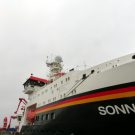*HZG: Helmholtz-Zentrum Geesthacht, Germany New tools for sampling and analysis of microplastic Apart from the primary plastics chasing activities using various types of nets on SO279, a group of three post-docs and PhD student from the Institute of Coastal Research, Helmholtz-Zentrum Geesthacht (HZG) are bringing something different to the expedition. As we are getting closer […]
SO279 – Secrets of the seabed
Deep sea sediments cover almost two thirds of the planet’s surface, yet they remain mostly unexplored and mysterious. Differently from what was thought in the past, they host greatly biodiverse communities associated to both soft and rocky substrates. From cold water corals (soft corals with no calcareous structure) to holothurians (sea cucumbers), from shrimps to […]
SO279 – It all started with the dinosaurs
Not only dinosaurs, but also marine phytoplankton and terrestrial plants were deposited and metamorphosed over time into oil. Some of that oil has been made into plastic that eventually made its way into the ocean. The basic chemical building blocks of plastic are well-known in nature, but anthropogenic long chain polymers are extremely difficult for […]
SO279 – Can you spot the plastic particle(s)?
Every time we use the nets to sample the water we find a lot of interesting stuff, ranging from fish and critters to heaps of sargassum seaweed, and often a number of fragments which appear to be plastics. But are they really plastics though? Can we distinguish for example between a piece of plastic foil, […]
SO279 – Sargassum patches everywhere
After the OFOS profile finished on 15 December, SONNE transited to Station 4. We arrived on 16 December at 4:00 in the morning and immediately began our sampling program. The box cores returned with rather strange sediments—fine grained carbonates that behaved somewhat like a non-Newtonian fluid. The sediment was soft when gently pressed or shaken, […]
SO279 – Calm sea and continuous sampling
Our 4-day transit to our next sampling station was finally finished on December 13 where we arrived on station no. 3 west of Madeira and the Canary Islands. The weather was as promised, with relatively calm seas, bright sunshine, and air temperatures approaching 20°C. The afternoon was dedicated to net-sampling. Erik Borchert from the Project […]
SO279 – First Sampling Station
Even though we had a bit of a swell, we were able to sample our first station on December 8. Besides a successful deployment of the CTD/Niskin rosette, which collects water throughout the water column, the underway seawater system, and pumps that filter in situ, we also deployed the box and multi corer for sediment. […]
SO279 Setting Sail
The research cruise with the German Research Vessel SONNE (SO279) focuses on the North Atlantic plastic transport mechanisms, sinks, and interactions with biota (NAPTRAM) and supports two major projects: the JPI-Oceans project HOTMIC (“HOrizontal and vertical oceanic distribution, Transport, and impact of MICroplastics”) and the BMBF funded project PLASTISEA (‘Harvesting the marine Plastisphere for novel […]
Recover and return
— Deutscher Text folgt unten — The fifth week of our cruise was dominated by the finalization of work and the coordination of the recovery of the PAP ODAS buoy. Following a general enquiry by British colleagues from National Oceanography Centre (NOC) to recover this scientific equipment, it had become clear that we could create […]
Image analysis
by Benson MbaniTwo weeks into my summer holiday, while dancing along to the Jerusalema dance challenge, an email came through which needed urgent action. Usually while on holiday, I only briefly check emails every few days, and only respond to urgent ones. It was from Dr. Timm Schoening – my supervisor and chief scientist for […]

